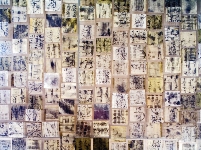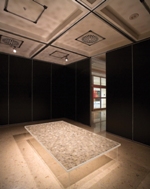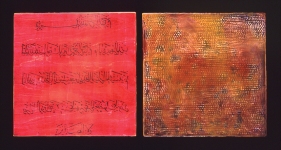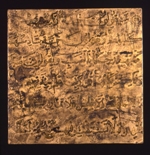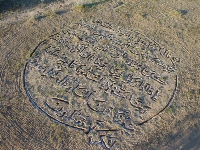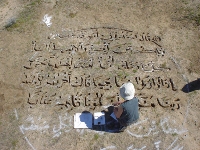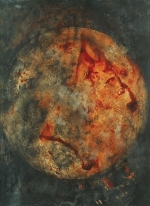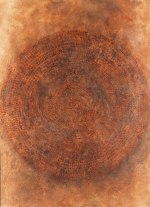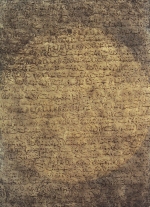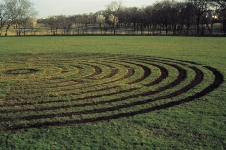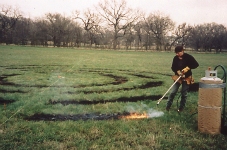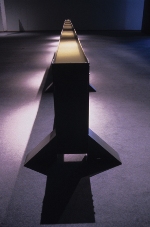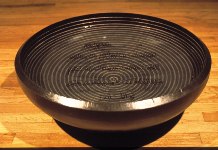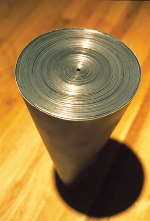Fall 2007, Volume 24.1
Art
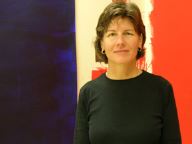
Suzanne Kanatsiz
Naming the Unnamed
Suzanne Kanatsiz (MFA, San José State University) is one of two daughters born to an American mother and a Turkish father. She has lived and traveled extensively in Europe and the Middle East, including a recent teaching appointment at Sabanci University in Istanbul. She has taught art to a diversity of populations, including disabled adults in San Francisco and incarcerated men and women in the California correctional system. Currently, she is a professor in the sculpture area of the visual arts at Weber State University. She lives with her husband and son in Utah and is represented by "A" Gallery in Salt Lake City.
Experimental and conceptual in nature, I work in the medium of sculpture, installation and drawing. The materials used are diverse and include combinations of the organic mixed with the machined or manufactured. The work has primitive features, such as fabrication by slow, laborious processes, and materials are often left raw with intuitive markings. Concentric rings, circles, and spheres are a significant part of my visual vocabulary combined with text, transparency and repetition. My forms are wide-ranging; relief panels, earthworks, steel sculptures, installations, drawings and more.
Arabic text has long been part of my work due to my Turkish heritage. When I choose excerpts from the Qur’an, I do so intuitively and use such passages as a visual experience, touching on human archetypes and universality, not to express semantic content.
Some of my works exist within the tension of juxtaposing classical Islamic thought and contemporary Western thought. In Islamic thought, the act of reading is privileged, while Western thought favors visual experience; seeing is the vehicle for acquiring knowledge. These two traditions have a significant difference in attitude towards the visual experience. This difference is my work’s determinant factor and is intended to be powerfully distinctive.
In Dislocation, 2006, I used more than a thousand fragments of rice paper with images of Qur’anic text from many different historical periods applied to both sides. I disintegrated the Arabic text and re-ordered it. In the final presentation, the paper fragments were dipped in beeswax and suspended between layers of Plexiglas in a horizontal, transparent sculpture. Meaning in this piece is emancipated from the text, from the word, and has been invested into a visual entity.
[Click on picture to enlarge.]
In Untitled Panels, I created ornate wood reliefs with traditional, respected materials such as gold leaf and encaustic. The materials and text images are then rubbed and subtracted to once again pose questions of meaning in the context of Eastern and Western culture.
In 2005, I created the earthwork Qu’ran Sura VII as part of a group exhibition in the desert. The site was next to Twenty-Nine Palms, a large military base near Joshua Tree, California. My intention was to deeply question the course of action we have taken in implementing the war in Iraq. Sura VII succinctly outlines how our actions impact future generations.
The carved Arabic penetrates six inches into the soil. Subsequently, I filled the text with salt. I used the following passage from the Qur’an, Sura VII, 38:
He will say: "Enter ye
In the company of
The Peoples who passed away
Before you—men and Jinns,—
Into the Fire. Every time
A new People enters,
It curses its sister—People
(That went before), until
They follow each other, all
Into the Fire. Saith the last
About the first: "Our Lord!
It is these that misled us:
So give them a double
Penalty in the Fire."
He will say: "Doubled
For all": but this
Ye do not understand.
Translation:
The earlier generations committed a double crime: (1) their own sins, (2) the bad example they set for those that followed. We are responsible not only for our own misdeeds, but for those which our example and our teaching to juniors may induce them to commit. Two crimes must have a double penalty. But we must understand "ten times" and "double" figuratively and not quantitatively.
In Drawing 1 and Drawing 2, I used my blood as pigment—genetic material from my body. In Drawing 1, I splashed my blood onto the paper, mixing it with inks, graphite and wax to attempt a visceral image of depth and intensity. In the process of making Drawing 2, I intended to enter a "trance-like" state—the duality of subtracting and then adding that subtraction to the paper. I used concentric blood fingerprints to make the image. In Drawing 3, I used texture to create rhythmic, fragmented Arabic text from the Qur’an.
In earlier works, such as Labyrinth, Trough, and Bowl, landscape and space are used as a context for the works. All are containers of different scales. Labyrinth was made at the Connemara Nature Conservancy in Texas in 2001. It was 200 ft. in diameter and created through a process of marking the earth by burning (subtracting). Burning was traditionally used in the Texas grasslands to rejuvenate the soil. Metaphorically, Labyrinth contained a path to wisdom through the process of subtraction. It was an ephemeral path, as the grass retook the landscape within three months of Labyrinth’s making.
Trough was made as a long, linear, steel container, which "floated" 6 ft. in the air. It was filled with water. Water and the fluidity of water were contained within the sculpture, both visible and temporary. In Bowl, I used the geometry of concentric rings carved into the thick steel to create a rhythmic landscape within which to float Arabic text etched into glass. The two parts together created a sacred object that was both a container and the contained simultaneously.
In my designs I take poetic excerpts from both Eastern and Western culture and transform them into visual equals that complement, rather than oppose, one another. Through the ephemeral (light), form (text), and depth (installation, repetition and multiple), my work elicits contemplation. I emphasize subtraction, posing questions of nothing, everything and endless parts in-between.
I strive to dynamically produce as an artist and challenge my work to greater depths of content, diversity and technical expertise. I believe in the power of art and its influence in the world. Through the process of making art, and refining my skills, I become open to life in a way that is profoundly transformative on both a personal and universal level.

